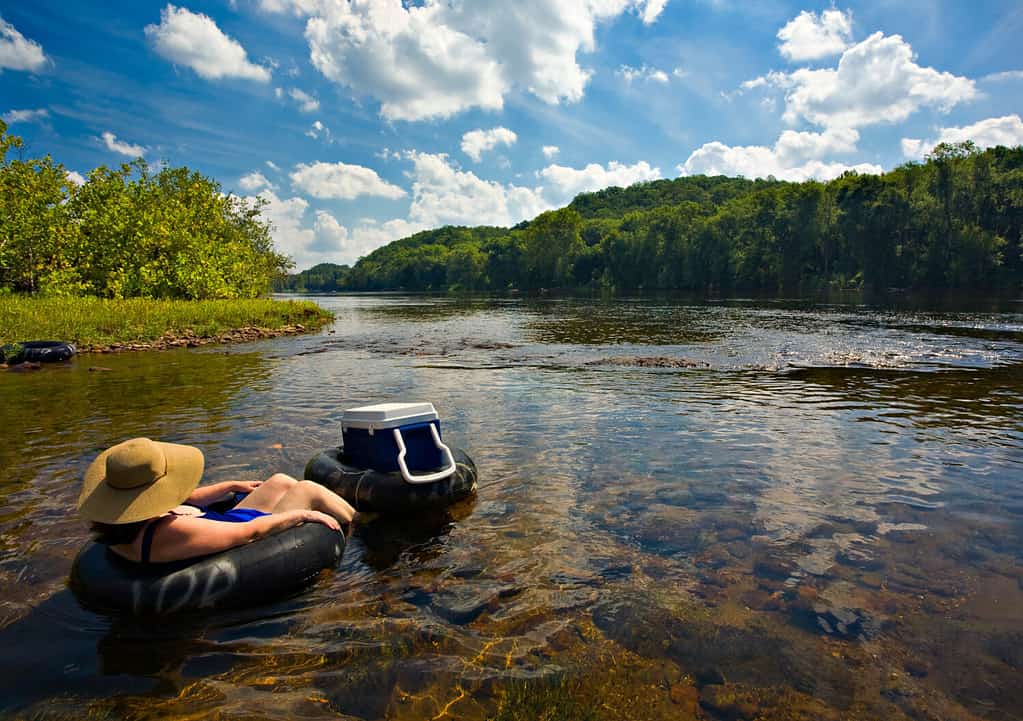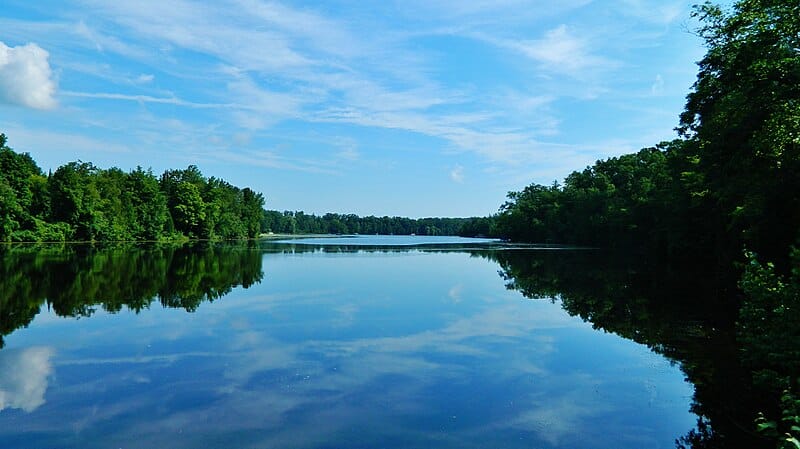How many times have you taken a walk along the rivers in Wisconsin? Making up over 56,000 miles of the state, only 276 miles are safe enough to walk along as a scenic tour. In total, it holds 12,600 rivers and streams, which is why so many people travel to swim, fish, and boat. As beautiful as the landscape is, dangers lie beneath the seemingly serene rivers and streams.
Fast-moving undercurrents constantly threaten to pull any swimmer far below the water’s surface, which contains an assortment of debris, pollution, and even human remains. With free-falling rocks that change the underwater terrain, officials prohibit jumping and diving from many ledges. The wildlife on land mostly stays away, but predatory fish with sharp teeth live within the waters, latching on if you seem like a threat. Let’s look at some of the threats that make Wisconsin’s rivers dangerous.
Severe Risk of Drowning: Statewide Rate of Drowning

Even if you are a good swimmer, the local drowning rate is average for the country, costing the lives of far too many people.
©jack looney photography/Shutterstock.com
One of the biggest risks of swimming in Wisconsin’s rivers is drowning. According to American Whitewater’s report on just the Wisconsin River, over half of the 22 recorded accidents resulted in death. Whether playing by the river or swimming along it, unpredictable conditions and personal errors both account for these fatalities. While the rivers encourage tourism and recreational activities, some of these fatal incidents happened while having fun during activities like tubing or canoeing. As recently as August 2023, local communities mourned the loss of two neighbors.
According to an NBC news report, these drownings continue to take the lives of tourists and locals alike. The dangers of the fast-paced rivers are powerful enough to pull you under or trap you beneath fallen trees and other debris. Unfortunately, many people make the mistake of not taking necessary safety precautions or putting their trust in the uncontrollable rivers.
While accidents happen, drowning is completely preventable. The Wisconsin Department of Natural Resources recommends always wearing a life jacket for activities in their rivers, lakes, and streams. Even if you walk along the river and suddenly reach a drop, the life jacket keeps your head above water. They explain, “No one has drowned while wearing a life jacket.”
Natural Dangers of Wisconsin’s Rivers

With several species of fish, amphibians, and reptiles, take caution with the nearby wildlife in the fast-moving Wisconsin rivers.
©iStock.com/Karel Bock
Flood Areas and Water Levels
Just like no one should trust that the water won’t pull them underneath, don’t trust the water levels. Wisconsin’s Baraboo River stretches 120 miles, making it the longest free-flowing river in the United States. Unfortunately, logjams throughout the sediment in the river’s waters make it hard to navigate, which only worsens during flooding. Plus, many water areas are thick with mud, making rising waters even harder to escape.
Flooding is fairly common near Wisconsin’s riverbanks, though the Baraboo is a major culprit. Most people wouldn’t believe the flood damage caused by this river because of the beautiful nature around it. Look closer at the water lines along the tree trunks – evidence of these repeated floods. Flooding usually happens because of excessive rainfall in the area during storms, making it the most common disaster that the entire state falls victim to.
River Flow Rates
When it comes to the speed of these rivers, even the calmest areas in Wisconsin change quickly. Whether the result of water level management in the nearby lakes or excessive rain, rivers speed up quickly. Wild Wisco Waters Canoe & Kayak Outfitters recommends taking this potential for danger seriously when setting up campsites or planning activities. Without this preparedness, you run the risk of not making it out of the way fast enough, which is the cause of death for far too many.
Part of the reason that river flow rates are unpredictable is the water depth, which suddenly drops at the edge of some sandbars. While some rivers won’t speed up much from a 3-inch drop, some areas of Wisconsin’s rivers are over 12 feet deep, and the flow of the waters at this depth is strong. If you need to get out of this scary situation, stay calm and float down the river until you reach a sandbar to use to get out.
Even if the river’s flow rate is normal, you still have to watch out for the brisk currents. These currents move so quickly with such strength that you need to plant your feet firmly not to fall over. Even adults manage to lose their footing in the banks when they get waist-deep despite being skilled swimmers.
Wildlife and Animals
Wisconsin’s diverse wildlife includes many animals, including the bald eagles, several hawk species, and deer. While its rivers have beavers, muskrats, and otters (among other animals), many of the river’s fish and other animals pose a significant threat. In the Upper Mississippi River that flows through Wisconsin, over 145 species of reptiles and amphibians thrive. No other Midwest river has such diversity.
One of the most dangerous animals is the sea lamprey. They look just like eels, and they latch onto their prey with a sharp row of teeth, breaking the surface to suck out their blood. The bite is quite painful, much like a snakehead. This type of fish has the same predatory features, except that their fins allow them to walk a short distance on land. Lake sturgeon, northern pike, and rattlesnakes also live in Wisconsin’s rivers, so keep an eye on where you wade and swim.
Even with this many species to consider, they largely keep to themselves and stay away from humans. The biggest dangers to humans only come when threatened. Staying safe means respecting the animals that already live near these rivers. Disrupting their habitats will only push them to be defensive. The true threat to humans is a lack of respect for the environment, so always be aware of your surroundings along the river.
Geographical Dangers

Though local rock formations are beautiful, looseness in the terrain causes new ones to fall constantly, changing the terrain and putting you at risk of direct contact.
©iStock.com/AlenaMozhjer
Keep an eye out for unsteady rock formations and other geographical dangers along these rivers. Amnicon River is famous for its outdoor recreational activities, but slippery rocks and fluctuating water levels make it dangerous. This river has no lifeguard to keep an eye on swimmers, so take every precaution. Avoid jumping and diving. As tempting as it may be, the Amnicon Falls State Park office prohibits jumping from the rock walls for this exact risk.
The dark waters along the Amnicon River hide anything beneath the surface. Even if you check local maps, new rocks always fall, changing the water levels and terrain of the bottom of the river. Sandbars are the biggest enemy of any swimmer or wader because the drop can be several feet deep, but they also pose a threat while boating. Some areas are shockingly deep, while others are too shallow for a boat to ride along.
Environmental Dangers
While you take the time to adventure along Wisconsin’s rivers, the local environment poses several risks. To defend yourself against the elements, start with applying sunscreen. The sun’s rays reflect off the river, making sunburns more likely.
Walking along the river puts you at risk for two local and natural problems – poison ivy and mosquitos. If you walk along any river’s shoreline in Wisconsin, watch for poison ivy. Even a slight brush against the skin can cause severe itching, climbing up vines and shrubs within grazing distance of any hike. Bug repellant is a must near these bodies of water because they tend to reside near backwaters and vegetation.
Most Dangerous Rivers in Wisconsin
Every riverside visit comes with at least a few risks, even if you need to watch out for the local insects. Still, a few rivers are more dangerous than others. The Wisconsin River is one of the most dangerous, but they are hardly the only dangerous spot.
Wisconsin River

While the river seems serine, the rising water levels and uneven depth make it dangerous in many segments.
©Corey Coyle / CC BY 3.0 – License
While drowning is a concern for any of these areas, the Chicago Tribune states that the lower section is the most dangerous. Despite constant visits from tourists, the greatest width of this river reaches 3,000 feet, and some areas are 28 feet deep. Sandbars move constantly within the river, and their instability is a major risk for anyone who tries to walk or wade. Many people find deep drops in sediment from one step to the next, and the undercurrent is ready to pull you under.
Mississippi River

Mississippi River is home to a lot of dangerous pollution and swift undercurrents.
©Joshua Mayer / CC BY-SA 2.0 – License
The Mississippi River is massive, and a significant chunk of it is in Wisconsin. It is one of the most dangerous rivers in the entire country, with a severely strong flow and powerful undercurrents. If you lose your balance and fall in, the likelihood of getting trapped under is high. Some waters have calmer currents in the Wisconsin section, but the pollution poses a new threat.
Much of the coastline along this river provides a steady path of pollution into the water due to road salting, farm runoff, and more. Since so many of these pollutants flow into the river, take caution where you choose to swim. Though the waters seem calm, steady, and clean, much of this river is the exact opposite. According to locals, debris left behind the water from pollutants and storms is impossible to avoid while boating. Unless you want to end up underwater with the trash and human remains, follow every safety precaution for the Mississippi River.
Apple River

If you dip in the Apple River segment in Wisconsin, protect yourself from drowning in fast currents with a life vest.
©Joshua Mayer / CC BY-SA 2.0 – License
Northern Wisconsin has a lush landscape, but the fast-flowing Apple River near Little Falls poses a great danger to swimmers of all skill levels. The rapid flow makes it a tourist destination for anyone who enjoys tubing, but the dangerous undercurrent begs to pull someone under. Since drowning is one of the biggest dangers in Wisconsin’s rivers, this particular body of water is one to stay away from.
Peshtigo River

The Peshtigo River’s dangerous currents have claimed the lives of several people, injuring many others without proper safety measures.
©Kenwkoun / CC BY-SA 4.0 Deed – License
Many of the fatal accidents and injuries come back to the Peshtigo River, including going under while floating on inner tubes or boating. Upstream rapids are too dangerous for swimming or boating because of the buildup from debris. Along with the speed of the current, Peshtigo River is the site of PFAS contamination, according to the Wisconsin Department of Natural Resources.
Dealing With an Emergency Along Wisconsin’s Rivers
If you feel confident in your journey to one of Wisconsin’s rivers, you must have a plan for emergencies. Ordinarily, the rivers are calm, but a swift shift in the weather is enough to cause surging water levels and rapid currents. Always keep a communication method handy, whether a phone or a radio. To ensure that emergency services find you quickly, take a mental note of each landing you pass.
The photo featured at the top of this post is © Aaron J Hill/Shutterstock.com
Thank you for reading! Have some feedback for us? Contact the AZ Animals editorial team.






